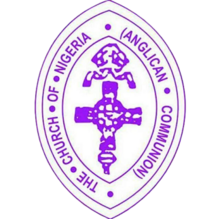
Back Church of Nigeria German Nigeriako Eliza Basque Nigerian anglikaanikirkko Finnish Église du Nigeria French Cocin Nigeria Hausa Ụka nke Naijiria IG 나이지리아 성공회 Korean Kerk van Nigeria Dutch Kościół Nigerii Polish Церковь Нигерии Russian
| The Church of Nigeria | |
|---|---|
 Seal of the Church of Nigeria. | |
| Classification | Protestant |
| Orientation | Anglican |
| Scripture | Holy Bible |
| Theology | Anglican doctrine |
| Polity | Episcopal |
| Primate | Henry Ndukuba |
| Associations | Anglican Communion, GAFCON, Global South |
| Headquarters | Abuja, Nigeria |
| Territory | Nigeria |
| Origin | 1842 1857 Expedition on the Niger[1][2][3] |
| Members | 18 million |
The Church of Nigeria is the Anglican church in Nigeria. It is the second-largest province in the Anglican Communion, as measured by baptised membership (not by attendance), after the Church of England. In 2016 it stated that its membership was “over 18 million",[4] out of a total Nigerian population of 190 million. It is "effectively the largest province in the Communion."[5] As measured by active membership, the Church of Nigeria has nearly 2 million active baptised members.[6][7] According to a study published by Cambridge University Press in the Journal of Anglican Studies, there are between 4.94 and 11.74 million Anglicans in Nigeria.[8][9] The Church of Nigeria is the largest Anglican province on the continent of Africa, accounting for 41.7% of Anglicans in Sub-Saharan Africa, and is "probably the first [largest within the Anglican Communion] in terms of active members."[10]
Since 2002 the Church of Nigeria has been organised into 14 ecclesiastical provinces. It has rapidly increased the number of its dioceses and bishops from 91 in 2002 to 161 as at January 2013. The administrative headquarters are located in Abuja. Archbishop Henry Ndukuba became its primate in 2020.
- ^ "Brief history of Church of Nigeria".
- ^ "History of the Church of Nigeria - Anglican Communion". 8 September 2016.
- ^ https://www.researchgate.net/publication/300821317_The_Church_of_Nigeria_Anglican_Communion [bare URL]
- ^ "World Council of Churches". January 1980. Retrieved 6 January 2016.
- ^ Nasralla, Shadia (2013-03-21). "UPDATE 1-Former oil executive becomes new head of Anglicans". Reuters. Retrieved 2021-07-25.
- ^ Muñoz, Daniel (May 2016). "North to South: A Reappraisal of Anglican Communion Membership Figures". Journal of Anglican Studies. 14 (1): 71–95. doi:10.1017/S1740355315000212. ISSN 1740-3553.
- ^ PM, Ruth Gledhill 12 November 2015 | 4:34 (12 November 2015). "Anglican membership figures could be out by millions". www.christiantoday.com. Retrieved 2021-07-25.
{{cite web}}: CS1 maint: numeric names: authors list (link) - ^ McKinnon, Andrew (July 3, 2020). "Demography of Anglicans in Sub-Saharan Africa: Estimating the Population of Anglicans in Kenya, Nigeria, South Africa, Tanzania and Uganda". University of Aberdeen.
- ^ McKinnon, Andrew (July 3, 2020). "Demography of Anglicans in Sub-Saharan Africa: Estimating the Population of Anglicans in Kenya, Nigeria, South Africa, Tanzania and Uganda". Journal of Anglican Studies. 18 (1): 42–60. doi:10.1017/S1740355320000170. hdl:2164/14774. ISSN 1740-3553. S2CID 214551113.
- ^ "Global Anglicanism at a Crossroads". Pew Research Center's Religion & Public Life Project. 2008-06-19. Retrieved 2021-07-25.
© MMXXIII Rich X Search. We shall prevail. All rights reserved. Rich X Search